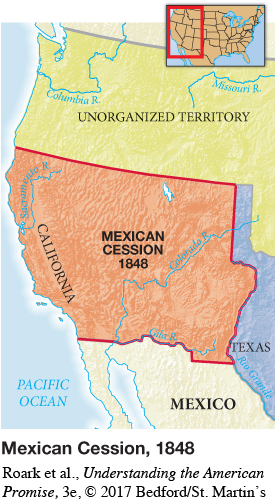The Wilmot Proviso and the Expansion of Slavery
Most Americans agreed that the Constitution left the issue of slavery to the individual states to decide. Northern states had done away with slavery, while southern states had retained it. But what about slavery in the nation’s territories? The Constitution states that “Congress shall have power to . . . make all needful rules and regulations respecting the territory . . . belonging to the United States.” The debate about slavery, then, turned toward Congress.
The spark for the national debate appeared in August 1846 when a Democratic representative from Pennsylvania, David Wilmot, proposed that Congress bar slavery from all lands acquired in the war with Mexico. The Mexicans had abolished slavery in their country, and Wilmot declared, “God forbid that we should be the means of planting this institution upon it.”
Regardless of party affiliation, Northerners lined up behind the Wilmot Proviso. Many supported free soil, by which they meant territory in which slavery would be prohibited, because they wanted to preserve the West for free labor, for hardworking, self-reliant free men, not for slaveholders and slaves. But support also came from those who were simply anti-South. New slave territories would eventually mean new slave states. Wilmot himself said his proposal would blunt “the power of slaveholders” in the national government.

Additional support for free soil came from Northerners who were hostile to blacks and wanted to reserve new land for whites. Wilmot understood what one Indiana man put bluntly: “The American people are emphatically a Negro-hating people.” Wilmot himself blatantly encouraged racist support when he declared, “I would preserve for free white labor a fair country, a rich inheritance, where the sons of toil, of my own race and own color, can live without the disgrace which association with negro slavery brings upon free labor.” It is no wonder that some called the Wilmot Proviso the “White Man’s Proviso.” [[LP Spot Map: SM14.01 Mexican Cession, 1848/
The thought that slavery might be excluded in the territories outraged white Southerners. Like Northerners, they regarded the West as a ladder for economic and social opportunity. They also believed that the exclusion of slavery was a slap in the face to southern veterans of the Mexican-American War. “When the war-worn soldier returns home,” one Alabaman asked, “is he to be told that he cannot carry his property to the country won by his blood?” In addition, southern leaders sought to maintain political parity with the North to protect the South’s interests, especially slavery. The need seemed especially urgent in the 1840s, when the North’s population and wealth were booming. James Henry Hammond of South Carolina predicted that ten new states would be carved from the acquired Mexican land. If free soil won, the North would “ride over us roughshod” in Congress, he claimed. “Our only safety is in equality of power.”
Foes of slavery’s expansion and foes of slavery’s exclusion squared off in the nation’s capital. Because Northerners had a majority in the House, they easily passed the Wilmot Proviso. In the Senate, however, where slave states outnumbered free states fifteen to fourteen, Southerners defeated it in 1847. Senator John C. Calhoun of South Carolina denied that Congress had the constitutional authority to exclude slavery from the nation’s territories. He argued that because the territories were the “joint and common property” of all the states, Congress could not bar citizens of one state from migrating with their property (including slaves) to the territories. Whereas Wilmot demanded that Congress slam shut the door to slavery, Calhoun called on Congress to hold the door wide open.
> CONSIDER CAUSE
AND EFFECT
Why did the Missouri Compromise, which had resolved disputes over the status of slavery in the western territories in 1820, fail to resolve them in the 1840s?
Senator Lewis Cass of Michigan offered a compromise through the doctrine of popular sovereignty, by which the people who settled the territories would decide for themselves slavery’s fate. This solution, Cass argued, sat squarely in the American tradition of democracy and local self-government. Popular sovereignty’s most attractive feature was its ambiguity about the precise moment when settlers could determine slavery’s fate. Northern advocates believed that the decision on slavery could be made as soon as the first territorial legislature assembled. With free-soil majorities likely because of the North’s greater population, they would shut the door to slavery immediately. Southern supporters believed that popular sovereignty guaranteed that slavery would be unrestricted throughout the entire territorial period. Only when settlers in a territory drew up a constitution and applied for statehood could they decide the issue of slavery. By then, slavery would have sunk deep roots. As long as the matter of timing remained vague, popular sovereignty gave hope to both sides.
When Congress ended its session in 1848, no plan had won a majority in both houses. Northerners who demanded no new slave territory anywhere, ever, and Southerners who demanded entry for their slave property into all territories, or else, staked out their extreme positions. Unresolved in Congress, the territorial question naturally became an issue in the presidential election of 1848.
Understanding the American Promise 3ePrinted Page 377
Section Chronology